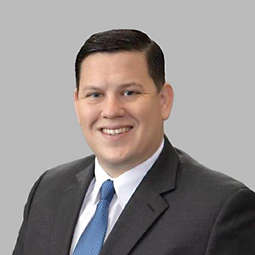Overview
Overview
The investment objective of NYLI CBRE Global Infrastructure Megatrends Term Fund1 (MEGI) is to seek a high level of total return with an emphasis on current income.
Thematic-based portfolio
Focused on the investment megatrends of decarbonization, digital transformation and asset modernization, which are reshaping the demand for infrastructure assets and driving income and growth potential.
Emphasis on current income
MEGI invests in companies generating resilient income from the ownership and operation of essential infrastructure assets. Distributions are expected to be paid to shareholders on a monthly basis which may be reinvested or taken in cash.2
Defined term structure
MEGI is structured with a 12-year limited term and intends to liquidate on or about December 15, 2033.3
MEGI Quarterly Webinar Update Q3 2025
We hosted a quarterly webinar with CBRE Investment Management on NYLI CBRE Global Infrastructure Megatrends Term Fund (MEGI).
IMPORTANT INFORMATION
- NYLI CBRE Global Infrastructure Megatrends Term Fund (NYSE: MEGI) Declares Monthly Distributions for December 2025, January and February 2026 and Availability of 19(a) Notice
- NYLI CBRE Global Infrastructure Megatrends Term Fund (NYSE: MEGI) Declares Availability of Section 19(a) Notice for November 2025
- NYLI CBRE Global Infrastructure Megatrends Term Fund (NYSE: MEGI) Declares Availability of Section 19(a) Notice for October 2025
- NYLI CBRE Global Infrastructure Megatrends Term Fund Announces Certified Results of 2025 Annual Meeting
- NYLI CBRE Global Infrastructure Megatrends Term Fund (NYSE: MEGI) Declares Monthly Distributions for September, October and November 2025 and Availability of 19(a) Notice
- NYLI CBRE Global Infrastructure Megatrends Term Fund (NYSE: MEGI) Declares Availability of Section 19(a) Notice for August 2025
- NYLI CBRE Global Infrastructure Megatrends Term Fund (NYSE: MEGI) Declares Availability of Section 19(a) Notice for July 2025
- NYLI CBRE Global Infrastructure Megatrends Term Fund (NYSE: MEGI) Declares Monthly Distributions for June, July and August 2025 and Availability of 19(a) Notice
- NYLI CBRE Global Infrastructure Megatrends Term Fund (NYSE: MEGI) Declares Availability of Section 19(a) Notice for May 2025
- NYLI CBRE Global Infrastructure Megatrends Term Fund (NYSE: MEGI) Declares Availability of Section 19(a) Notice for April 2025
- NYLI CBRE Global Infrastructure Megatrends Term Fund (NYSE: MEGI) Declares Monthly Distributions for March, April and May 2025 and Availability of 19(a) Notice
- NYLI CBRE Global Infrastructure Megatrends Term Fund (NYSE: MEGI) Declares Monthly Distribution for February 2025 and Availability of 19(a) Notice
- NYLI CBRE Global Infrastructure Megatrends Term Fund (NYSE: MEGI) Declares Monthly Distribution for January 2025 and Availability of 19(a) Notice
- NYLI CBRE Global Infrastructure Megatrends Term Fund (NYSE: MEGI) Declares Monthly Distribution for December 2024 and Availability of 19(a) Notice
- NYLI CBRE Global Infrastructure Megatrends Term Fund (NYSE: MEGI) Declares Monthly Distribution for November 2024 and Availability of 19(a) Notice
- NYLI CBRE Global Infrastructure Megatrends Term Fund (NYSE: MEGI) Declares Monthly Distribution for October 2024 and Availability of 19(a) Notice
- NYLI CBRE Global Infrastructure Term Fund Announces Certified Results of 2024 Annual Meeting
- NYLI CBRE Global Infrastructure Megatrends Term Fund (NYSE: MEGI) Declares Monthly Distribution for September 2024 and Availability of 19(a) Notice
- MainStay CBRE Global Infrastructure Megatrends Term Fund (NYSE: MEGI) Declares Monthly Distribution for August 2024 and Availability of 19(a) Notice
- MainStay CBRE Global Infrastructure Megatrends Term Fund (NYSE: MEGI) Declares Monthly Distribution for July 2024 and Availability of 19(a) Notice
- MainStay CBRE Global Infrastructure Megatrends Term Fund (NYSE: MEGI) Announces Portfolio Manager Update Webinar Thursday, July 18, 2024
- MainStay CBRE Global Infrastructure Megatrends Term Fund (NYSE: MEGI) Declares Monthly Distribution for June 2024 and Availability of 19(a) Notice
- MainStay CBRE Global Infrastructure Megatrends Term Fund (NYSE: MEGI) Declares Monthly Distribution for May 2024 and Availability of 19(a) Notice
- MainStay CBRE Global Infrastructure Megatrends Term Fund (NYSE: MEGI) Declares Monthly Distribution for April 2024 and Availability of 19(a) Notice
- MainStay CBRE Global Infrastructure Megatrends Term Fund (NYSE: MEGI) Declares Monthly Distribution for March 2024 and Availability of 19(a) Notice
- MainStay CBRE Global Infrastructure Megatrends Term Fund (NYSE: MEGI) Declares Monthly Distribution for February 2024 and Availability of 19(a) Notice
- MainStay CBRE Global Infrastructure Megatrends Term Fund (NYSE: MEGI) Declares Monthly Distribution for January 2024 and Availability of 19(a) Notice
- MainStay CBRE Global Infrastructure Megatrends Term Fund (NYSE: MEGI) Declares Monthly Distribution for December 2023 and Availability of 19(a) Notice
- MainStay CBRE Global Infrastructure Megatrends Term Fund (NYSE: MEGI) Declares Monthly Distribution for November 2023 and Availability of 19(a) Notice
- MainStay CBRE Global Infrastructure Megatrends Term Fund (NYSE: MEGI) Declares Monthly Distribution for October 2023 and Availability of 19(a) Notice
- MainStay CBRE Global Infrastructure Megatrends Term Fund (NYSE: MEGI) Declares Monthly Distribution for September 2023 and Availability of 19(a) Notice
- MainStay CBRE Global Infrastructure Megatrends Term Fund (NYSE: MEGI) Declares Increased Monthly Distribution for August 2023 and Availability of 19(a) Notice
- Press Release: MainStay CBRE Global Infrastructure Megatrends Term Fund (NYSE: MEGI) Announces a 15% Increase to the Distribution Rate and Webinar with Portfolio Management on August 9th, 2023
- Press Release: MainStay CBRE Global Infrastructure Megatrends Term Fund (NYSE: MEGI) Declares Monthly Distribution for July 2023 and Availability of 19(a) Notice
- Press Release: New York Life Investments Announces Name Change for the MainStay CBRE Global Infrastructure Megatrends Fund
- Press Release: MainStay CBRE Global Infrastructure Megatrends Fund (NYSE: MEGI) Declares Monthly Distribution for June 2023 and Availability of 19(a) Notice
- Press Release: MainStay CBRE Global Infrastructure Megatrends Fund (NYSE: MEGI) Declares Monthly Distribution for May 2023 and Availability of 19(a) Notice
- Press Release: MainStay CBRE Global Infrastructure Megatrends Fund (NYSE: MEGI) Announces Portfolio Manager Update Webinar Tuesday, April 25, 2023
- Press Release: MainStay CBRE Global Infrastructure Megatrends Fund (NYSE: MEGI) Declares Monthly Distribution for April 2023 and Availability of 19(a) Notice
- Press Release: MainStay CBRE Global Infrastructure Megatrends Fund (NYSE: MEGI) Declares Monthly Distribution for March 2023 and Availability of 19(a) Notice
- Press Release: MainStay CBRE Global Infrastructure Megatrends Fund (NYSE: MEGI) Declares Monthly Distribution for February 2023 and Availability of 19(a) Notice
- Press Release: MainStay CBRE Global Infrastructure Megatrends Fund (NYSE: MEGI) Declares Monthly Distribution for January 2023 and Availability of 19(a) Notice
- Press Release: MainStay CBRE Global Infrastructure Megatrends Fund (NYSE: MEGI) Announces Portfolio Manager Update Webinar Wednesday, January 18, 2023
- Press Release: MainStay CBRE Global Infrastructure Megatrends Fund (NYSE: MEGI) Declares Monthly Distribution for December 2022 and Availability of 19(a) Notice
- Press Release: MainStay CBRE Global Infrastructure Megatrends Fund (NYSE: MEGI) Declares Monthly Distribution for November 2022 and Availability of 19(a) Notice
- Press Release: MainStay CBRE Global Infrastructure Megatrends Fund (NYSE: MEGI) Declares Monthly Distribution for October 2022 and Availability of 19(a) Notice
- Press Release: MainStay MacKay DefinedTerm Municipal Opportunities Fund and MainStay CBRE Global Infrastructure Megatrends Fund Announce Departure of Yie-Hsin Hung from the Board of Trustees
- MainStay CBRE Global Infrastructure Megatrends Fund (NYSE: MEGI) Announces Portfolio Manager Update Call Thursday, October 20, 2022
- Press Release: MainStay CBRE Global Infrastructure Megatrends Fund (NYSE: MEGI) Declares Monthly Distribution for September 2022 and Availability of 19(a) Notice
- Press Release: MainStay CBRE Global Infrastructure Megatrends Fund (NYSE: MEGI) Declares Monthly Distribution for August 2022 and Availability of 19(a) Notice
- Press Release: MainStay CBRE Global Infrastructure Megatrends Fund (NYSE: MEGI) Declares Monthly Distribution for July 2022 and Availability of 19(a) Notice
- Press Release: MainStay CBRE Global Infrastructure Megatrends Closed-End Fund (NYSE: MEGI) Announces Availability of 19(a) Notice (June 2022)
- Press Release: MainStay CBRE Global Infrastructure Megatrends Closed-End Fund (NYSE: MEGI) Announces Availability of 19(a) Notice (May 2022)
- MainStay CBRE Global Infrastructure Megatrends Fund (NYSE: MEGI) Announces Portfolio Manager Update Call Wednesday, April 27, 2022
- Press Release: MainStay CBRE Global Infrastructure Megatrends Closed-End Fund (NYSE: MEGI) Announces Availability of 19(a) Notice (April 2022)
- Forms 3, 4, 5
- Proxy Voting Information
Performance
Performance
Returns represent past performance which is no guarantee of future results. Current performance may be lower or higher. Investment return and principal value will fluctuate, and shares, when redeemed, may be worth more or less than their original cost. Expenses stated are as of the fund's most recent prospectus.
-
DateClosing PriceNAVPremium/Discount
Portfolio
Portfolio
Distribution & Yields
Distribution & Yields
* There is no assurance the Fund will continue to pay regular monthly distributions or that it will do so at a particular rate.
You should not draw any conclusions about the Fund’s investment performance from the amount of its distribution to shareholders.
Any distributions in excess of the Fund’s current and accumulated earnings and profits will be treated first, as a tax-deferred return of capital, which is applied against and will reduce the adjusted tax basis of shares and, after such adjusted basis is reduced to zero, will generally constitute capital gains. A return of capital distribution may lower a shareholder’s basis in the Fund, causing a potential future tax consequence in connection with the sale of Fund shares, even if such shares are sold at a loss to the shareholder’s initial investments.
Any amounts and sources of distributions are only estimated and are not being provided for tax reporting purposes. The actual amounts and sources of income of the amounts for tax reporting purposes will depend on the Fund’s investment experience during the remainder of its fiscal year and may be subject to changes based on tax regulations. The Fund will send a Form 1099-DIV for the calendar year that will advise how to report these distributions for federal income tax purposes.
Distribution Rate: Distribution rate is calculated by annualizing the most recent distribution per share (dividing the number of calendar days during the year by the number of calendar days over which the most recent distribution accumulated) and dividing it by the NAV. The Fund intends to pay monthly distributions from net investment income.
The 30 Day SEC Yield is calculated by dividing the net investment income per share for the first 30 days of the month by the offering price per share at the end of that period. The yield reflects the dividends and interest earned during the period, after the deduction of the Fund's expenses. Yield reflects a fee waiver and/or expense limitation agreement without which the 30 Day SEC Yield would have been lower.
Team
Team
Real asset investment specialist.
Industry leading, real asset investment specialist with an unmatched global network and research platform.

Jeremy Anagnos
Chief Investment Officer, Listed Infrastructure

Joseph P. Smith
CIO - Listed Strategies

Hinds Howard
Portfolio Manager

Daniel Foley
Portfolio Manager





